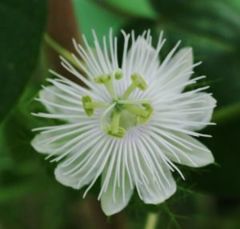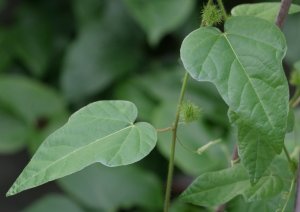Passiflora foetida
Dysosmia foetida(L.) M.Roem.
Dysosmia gossypifolia(Desv. ex Ham.) M.Roem.
Dysosmia hastata(Bertol.) M.Roem.
Dysosmia hibiscifolia(Lam.) M.Roem.
Dysosmia nigelliflora(Hook.)M.Roem.
Granadilla foetida(L.) Gaertn.
Passiflora baraquinianaLem.
Passiflora ciliataDryand.
" Dysosmia fluminensisM.Roem.
Dysosmia foetida(L.) M.Roem.
Dysosmia gossypifolia(Desv. ex Ham.) M.Roem.
Dysosmia hastata(Bertol.) M.Roem.
Dysosmia hibiscifolia(Lam.) M.Roem.
Dysosmia nigelliflora(Hook.)M.Roem.
Granadilla foetida(L.) Gaertn.
Passiflora baraquinianaLem.
Passiflora ciliataDryand.
"
| Foetid Passion Flower {{{status}}} Fossil range: {{{fossil_range}}}
| ||||||||||||||||||||||||||||||||||||||||||||||||||||||||||||||||||
|---|---|---|---|---|---|---|---|---|---|---|---|---|---|---|---|---|---|---|---|---|---|---|---|---|---|---|---|---|---|---|---|---|---|---|---|---|---|---|---|---|---|---|---|---|---|---|---|---|---|---|---|---|---|---|---|---|---|---|---|---|---|---|---|---|---|---|
 Passiflora foetida flower | ||||||||||||||||||||||||||||||||||||||||||||||||||||||||||||||||||
| Plant Info | ||||||||||||||||||||||||||||||||||||||||||||||||||||||||||||||||||
| ||||||||||||||||||||||||||||||||||||||||||||||||||||||||||||||||||
| Scientific classification | ||||||||||||||||||||||||||||||||||||||||||||||||||||||||||||||||||
| ||||||||||||||||||||||||||||||||||||||||||||||||||||||||||||||||||
| [[{{{diversity_link}}}|Diversity]] | ||||||||||||||||||||||||||||||||||||||||||||||||||||||||||||||||||
| {{{diversity}}} | ||||||||||||||||||||||||||||||||||||||||||||||||||||||||||||||||||
| Binomial name | ||||||||||||||||||||||||||||||||||||||||||||||||||||||||||||||||||
| Passiflora foetida L. | ||||||||||||||||||||||||||||||||||||||||||||||||||||||||||||||||||
| Trinomial name | ||||||||||||||||||||||||||||||||||||||||||||||||||||||||||||||||||
| {{{trinomial}}} | ||||||||||||||||||||||||||||||||||||||||||||||||||||||||||||||||||
| Type Species | ||||||||||||||||||||||||||||||||||||||||||||||||||||||||||||||||||
| {{{type_species}}} | ||||||||||||||||||||||||||||||||||||||||||||||||||||||||||||||||||
| {{{subdivision_ranks}}} | ||||||||||||||||||||||||||||||||||||||||||||||||||||||||||||||||||
| [[Image:{{{range_map}}}|{{{range_map_width}}}|]] | ||||||||||||||||||||||||||||||||||||||||||||||||||||||||||||||||||
| Synonyms | ||||||||||||||||||||||||||||||||||||||||||||||||||||||||||||||||||
| Dysosmia ciliata M.Roem. Dysosmia fluminensis M.Roem. |
The Foetid Passion Flower or Stinking Passion Flower (Passiflora foetida), also known as the Wild Maracuja or Running Pop, is a creeping vine which has an edible fruit and leaves that have a mildly rank aroma. It is native to northern South America and the West Indies; it can also be found in South East Asian countries like Vietnam and on Hawaii.

The stems are thin, wiry and woody, covered with sticky yellow hairs. The leaves are three- to five-lobed and viscid-hairy. They give off an unpleasant odour when crushed. The flowers are white to pale cream coloured, about 5-6 cm diameter. The fruit is globose, 2-3 cm diameter, yellowish-orange to red when ripe, and has numerous black seeds embedded in the pulp; the fruit are eaten and the seeds dispersed by birds.
The bracts of this plant serve as insect traps, but it is as yet unknown whether the plant digests and gains nourishment from the trapped insects or if it merely uses the bracts as a defensive mechanism to protect its flowers and fruit. This is still an issue of debate and research among carnivorous plant enthusiasts.
This passion flower tolerates arid ground, but favours wet areas. It is known to be an invasive species in some areas.
- Uses
The fruits are kumquat sized with a thin, scarlet red shell surrounding a blush-white pulp, mildly sweet, delicately flavored. Young leaves and plant tips are edible. Dry leaves are used in tea in Vietnamese folk medicine to relieve sleeping problems.
-
Passiflora foetida: climbing tendril
-
Fruits
-
Flower
-
Bracts
References
- Defence and Carnivory: dual role of bracts in Passiflora foetida abstract from Journal of Biosciences 20(5): 657-664, December 1995.
- List of plants of Caatinga vegetation of Brazil



